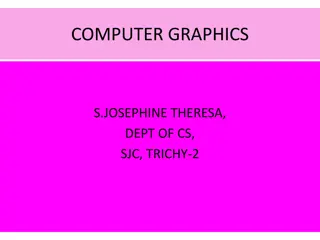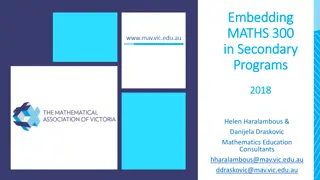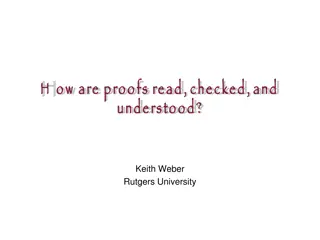Enhancing Mathematical Understanding through Drawing Activities
Exploring the cognitive benefits of drawing-to-learn activities in undergraduate mathematics, this content delves into visual proofs, historical mathematical concepts, and the importance of communication in mathematics. Visual thinking, creative representations, and the power of visualization are emphasized as tools for improved comprehension and problem-solving in mathematics education.
Uploaded on Oct 09, 2024 | 0 Views
Download Presentation

Please find below an Image/Link to download the presentation.
The content on the website is provided AS IS for your information and personal use only. It may not be sold, licensed, or shared on other websites without obtaining consent from the author. Download presentation by click this link. If you encounter any issues during the download, it is possible that the publisher has removed the file from their server.
E N D
Presentation Transcript
DRAWING-TO-LEARN ACTIVITY AS A COGNITIVE TOOL IN UNDERGRADUATE MATHEMATICS Mil Krajcevski University of South Florida mile@mail.usf.edu MAA MathFest 2018, Denver, August 1-4
OUTLINE Visual proofs in mathematics and in education Cognitive power of visualization. One way to go: drawing-to-learn Drawing in LA
Euclids Elements, Proposition 1 To construct an equilateral triangle on a given finite straight line
Karl Weierstrass continuous everywhere but differentiable nowhere (1872)
Peanos space-filling curve (1890) Is it possible that plane curves which are mathematical objects, may possess properties that are so disparate from the physical properties of ropes which apparently they are supposed to represent. Is our intuition that unreliable?
We mathematicians need to put far greater effort into communicating mathematical ideas. To accomplish this, we need to pay much more attention to communicating not just our definitions, theorems, and proofs, but also our ways of thinking. We need to appreciate the value of different ways of thinking about the same mathematical structure. William P. Thurston On proof and progress in mathematics (p 168) Bulletin of AMS Vol 30, #2, April 1994 e
Phillips, Norris and Macnab Visualization in Mathematics, Reading and Science Education, Springer 2010 Visualization objects are physical objects that are viewed and interpreted by a person for the purpose of understanding something other than the object itself. These objects can be pictures, 3D representations, animations, etc. Introspective visualization Interpretive visualization
Following Quillin and Thomas Drawing - to - Learn: A Framework for Using Drawings to Promote Model-Based Reasoning in Biology CBE-Life Sciences Education, Vol.14, 1-16, Spring 2015 Drawing-to-learn is a learner-generated activity in which a practitioner creates a 2D external representation of a mathematical object, proposition or a configuration on any medium, for the purpose of understanding something other than the object itself.
Diminishing role of geometry in high school curriculum is contributing factor for students reluctance to explore visual thinking in problem solving situations.
Our own research indicates that Students are capable of producing/drawing reasonably good images of lines, polygons, circles, cubes, during an enacted lession, but... they would rearly reach for a visual representation of a given problem even in cases when it will significantly reduce the complexity of the problem and provide an appealing path towards successful resolution. Students inclination to use visual images during problem solving Krajcevski and Keene, SIGMAA on RUME 2017, San Diego
How much geometry do we need? a b = + + = a||b = A c D b b f a a d F B E C
Given vectors u, v, and w as shown, let T be a linear transformation that transforms vectors u and v to vectors T(u) and T(v) respectively. Sketch the vector T(w). T(w)=? T(v) v w O O T T(u) u Also sketch the vector T( u + 2v).
Given vectors u, v, and w as shown, let T be a linear transformation that transforms vectors u and v to vectors T(u) and T(v) respectively. Sketch the vector T(w). T(w)=? T(v) v w O O T T(u) u Also sketch the vector T( u + 2v).
If u is an unit vector a an arbitrary nonzero vector so that the angle between u and a is ,we define the number a u as |a|cos
Looking at a linear transformation as something that transforms the square grid of the domain into parallelogram grid in the range helps student grasp the notion of eigenvector, among other things.
We may begin with familiar picture of the 3D Cartesian Coordinate System.
Unless we label our axes, neither our position nor the position of the object we want to visualize, is determined.
Moving towards xz plane (assuming we are in the first octant) Moving towards xz plane (assuming we are in the fifth octant)
You can position yourself in the fifth octant and see the objects in the first octant from below .
Sketching a vector in three space. What can go wrong?
Representing a vector as a diagonal of a rectangle in 3D space or a diagonal of a box
Similar arguments about ambiguity of the position of an object applies to a the sketch of a line in space. It helps if specify two points on the line with especially when these points belong to some of the coordinate planes.
Most interesting lines in linear algebra course are the lines that pass through the origin. These are our subspaces or kernels of linear transformations. We see that we face the same problems as in the case of vectors and points.
As we know, the graph of the equation ax + by +cz = d (assume d 0) is a plane in space. What portion of the plane is represented on the picture depends on the sign of the coefficients a, b, and c.
How can we extract mathematical information from this figure? After specifying the red vectors in the figure one can ask for a sketch of the subspace generated by these vectors. One can ask if a specific vector (say k) belongs to the span or what can we say about b and c if the vector ( 0, b, c ) belongs to the span.
We may answer even more complicated situations visually: If vectors a,b, and c pictured below, is c a vector in Span {a,b}?
From elementary through middle school and high school, manipulatives and modeling are integral parts of how students acquire mathematical knowledge and develop their cognitive skills. Research shows that long-term use of manipulatives has a positive effect on student achievement by allowing students to use concrete objects to observe, model and internalize mathematical concepts. This inquiry model is abruptly abandoned at the college level.
What we propose is a mathematical practice that will continue with modeling and use of manipulatives at the undergraduate level by exploring free hand drawing of notions or mathematical objects whenever possible. Visualized objects (on paper, whiteboard or computer screen) can still be manipulated, modified, enhanced or erased and could play the role of missing manipulative object.






















